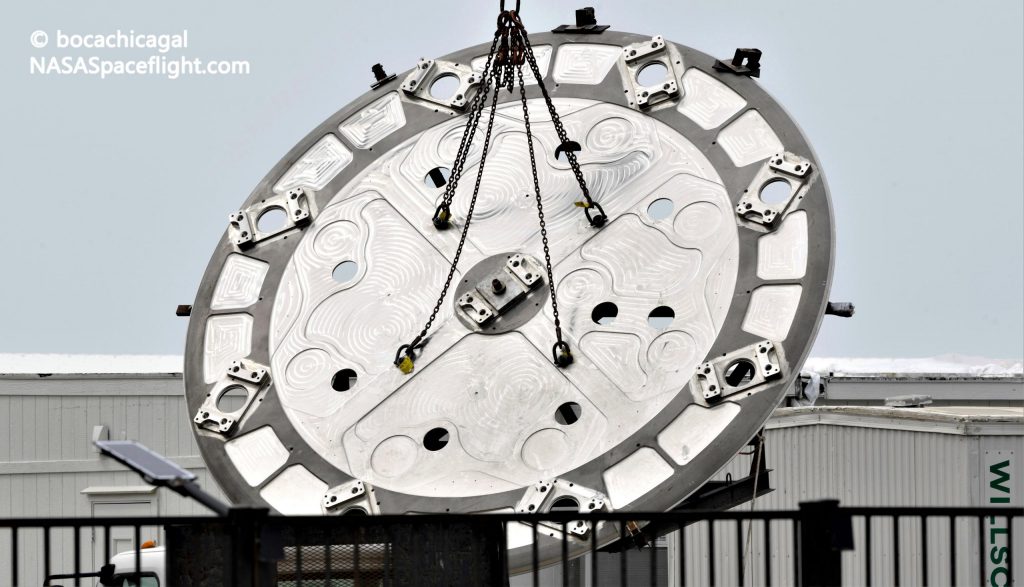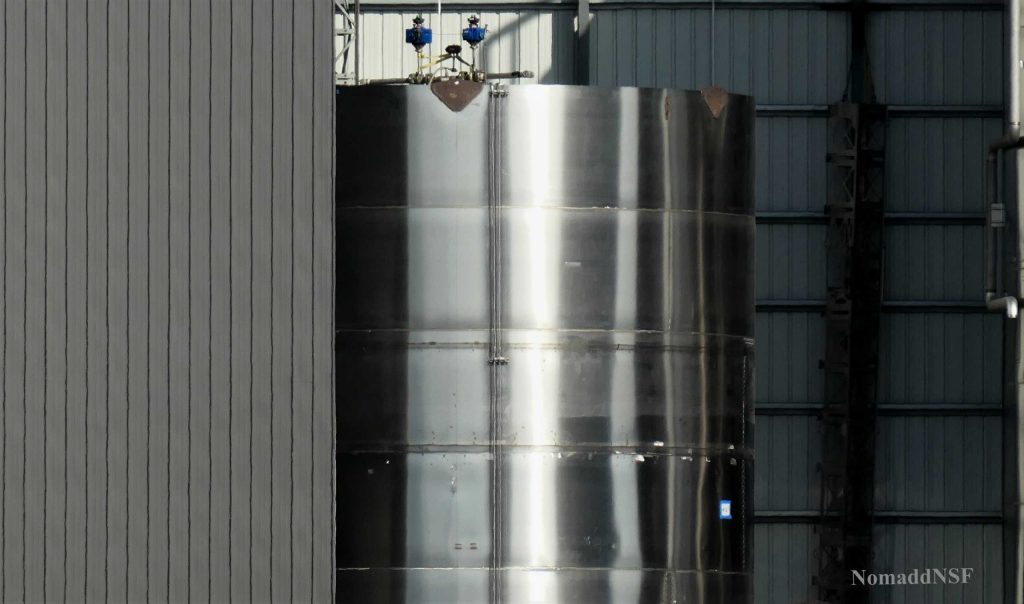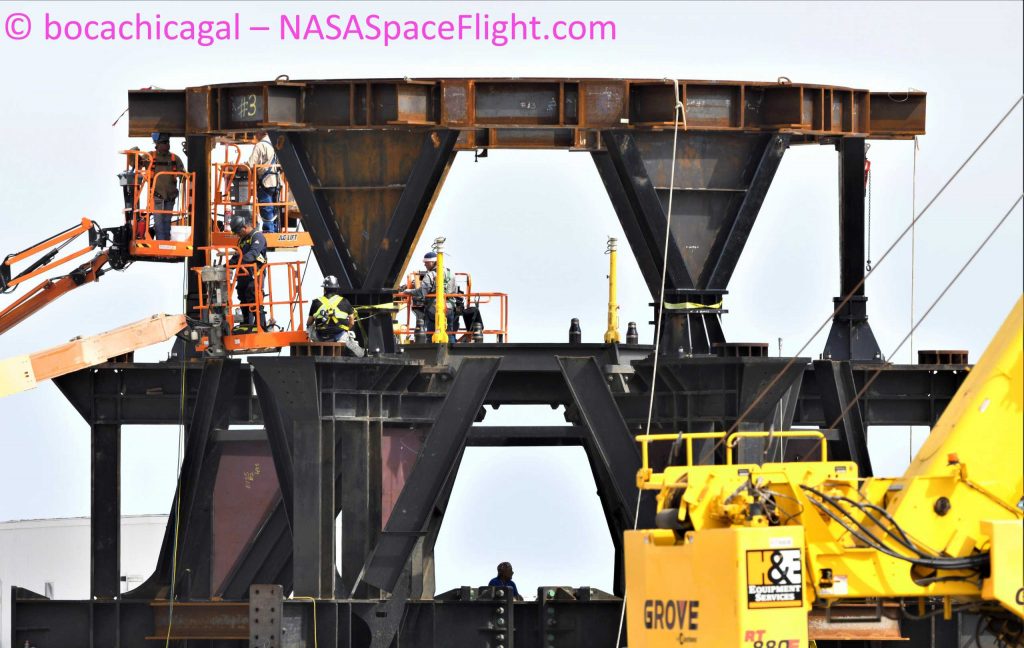

News
SpaceX first Super Heavy ‘test tank’ is almost ready for prime time
SpaceX has almost completed a ‘test tank’ meant to ensure that Starship’s Super Heavy booster is capable of withstanding the immense thrust of more than two-dozen Raptor engines.
Believed to be known as test tank BN2.1, the prototype’s latest appearance comes on the heels of news from CEO Elon Musk that SpaceX has upgraded Super Heavy with one extra Raptor engine – with plans to add another three down the road. The results of that tank’s imminent test campaign will likely be crucial as the company shifts its focus sending Starship to orbit (or close) as soon as possible.
Prior to a new Super Heavy booster ‘thrust puck’ design first spotted on May 29th, at least two separate booster engine section prototypes completed in the last few months sported an earlier variant more akin to a donut. At that point, Super Heavy’s design had a central cluster of eight gimballing, throttleable Raptors surrounded by a ring of 20 Raptor Boost (“RBoost”) engines – a variant meant to trade the ability to throttle for ~25% more thrust.

While Super Heavy booster BN1’s almost immediate scrapping – prior to a single test – guaranteed that major design changes were on the way, exactly what those changes would be was anyone’s guess. The appearance of a new booster ‘thrust puck’ design and Musk’s subsequent announcement that Super Heavy will “initially” have 29 – not 28 – Raptors likely mean that that engine section redesign was a major contributor to BN1’s instant obsolescence. The only other major change SpaceX clearly made with booster BN2 was switching the positions of its liquid methane and liquid oxygen tanks, ensuring that Super Heavy’s heavier oxidizer is closer to the rocket’s base.
Musk also stated that SpaceX will eventually upgrade Super Heavy to 32 engines, giving future boosters a central cluster of 12 engines that the SpaceX CEO says will significantly improve the efficiency of boostback burns.
With 29 identical Raptors, the simplest possible Super Heavy booster would produce up to 5800 tons (12.8M lbf) of thrust at liftoff. If SpaceX has already completed Raptor Boost’s design and qualification and kicked off mass production of a 250-mTf engine, that liftoff thrust climbs to 6800 tons (~15M lbf). If SpaceX achieves performance goals (~210 mTf stock; ~300 mTf RBoost) mentioned by Musk last year, a 32-engine Super Heavy could achieve peak liftoff thrust greater than 8500 metric tons (~18.7M lbf).
Even in its weakest configuration, Super Heavy will still be more than 60% more powerful than Saturn V and 25% more powerful than N1 – the largest rockets to have ever successfully or unsuccessfully flown. That immense thrust demands a structure capable of surviving those extreme forces while simultaneously feeding dozens of Raptors up to ~28 metric tons (~61,000 lb) of propellant every second and withstanding several thousand tons of liquid oxygen – all without leaking, cracking, or flexing too much.


While BN2.1 wont have any of the plumbing associated with dozens of Raptors, nine hydraulic rams will let SpaceX subject its Super Heavy thrust structure to the simulated thrust of some number of engines. Given the presence of nine rams and nine clustered engines, it’s unclear if BN2.1 will only test that main thrust structure or if those rams will somehow be spread out to simulate the thrust of a full 29 engines – 20 of which will instead transfer most or all of their thrust into Super Heavy’s skirt.
Regardless, if successful, BN2.1’s test campaign should leave SpaceX on track to attempt Starship’s inaugural spaceflight as early as Q3 2021. If issues arise, that target could easily slip to Q4 or into 2022, but SpaceX’s test tank campaigns have historically been very successful.

News
Tesla is not sparing any expense in ensuring the Cybercab is safe
Images shared by the longtime watcher showed 16 Cybercab prototypes parked near Giga Texas’ dedicated crash test facility.

The Tesla Cybercab could very well be the safest taxi on the road when it is released and deployed for public use. This was, at least, hinted at by the intensive safety tests that Tesla seems to be putting the autonomous two-seater through at its Giga Texas crash test facility.
Intensive crash tests
As per recent images from longtime Giga Texas watcher and drone operator Joe Tegtmeyer, Tesla seems to be very busy crash testing Cybercab units. Images shared by the longtime watcher showed 16 Cybercab prototypes parked near Giga Texas’ dedicated crash test facility just before the holidays.
Tegtmeyer’s aerial photos showed the prototypes clustered outside the factory’s testing building. Some uncovered Cybercabs showed notable damage and one even had its airbags engaged. With Cybercab production expected to start in about 130 days, it appears that Tesla is very busy ensuring that its autonomous two-seater ends up becoming the safest taxi on public roads.
Prioritizing safety
With no human driver controls, the Cybercab demands exceptional active and passive safety systems to protect occupants in any scenario. Considering Tesla’s reputation, it is then understandable that the company seems to be sparing no expense in ensuring that the Cybercab is as safe as possible.
Tesla’s focus on safety was recently highlighted when the Cybertruck achieved a Top Safety Pick+ rating from the Insurance Institute for Highway Safety (IIHS). This was a notable victory for the Cybertruck as critics have long claimed that the vehicle will be one of, if not the, most unsafe truck on the road due to its appearance. The vehicle’s Top Safety Pick+ rating, if any, simply proved that Tesla never neglects to make its cars as safe as possible, and that definitely includes the Cybercab.
Elon Musk
Tesla’s Elon Musk gives timeframe for FSD’s release in UAE
Provided that Musk’s timeframe proves accurate, FSD would be able to start saturating the Middle East, starting with the UAE, next year.

Tesla CEO Elon Musk stated on Monday that Full Self-Driving (Supervised) could launch in the United Arab Emirates (UAE) as soon as January 2026.
Provided that Musk’s timeframe proves accurate, FSD would be able to start saturating the Middle East, starting with the UAE, next year.
Musk’s estimate
In a post on X, UAE-based political analyst Ahmed Sharif Al Amiri asked Musk when FSD would arrive in the country, quoting an earlier post where the CEO encouraged users to try out FSD for themselves. Musk responded directly to the analyst’s inquiry.
“Hopefully, next month,” Musk wrote. The exchange attracted a lot of attention, with numerous X users sharing their excitement at the idea of FSD being brought to a new country. FSD (Supervised), after all, would likely allow hands-off highway driving, urban navigation, and parking under driver oversight in traffic-heavy cities such as Dubai and Abu Dhabi.
Musk’s comments about FSD’s arrival in the UAE were posted following his visit to the Middle Eastern country. Over the weekend, images were shared online of Musk meeting with UAE Defense Minister, Deputy Prime Minister, and Dubai Crown Prince HH Sheikh Hamdan bin Mohammed. Musk also posted a supportive message about the country, posting “UAE rocks!” on X.
FSD recognition
FSD has been getting quite a lot of support from foreign media outlets. FSD (Supervised) earned high marks from Germany’s largest car magazine, Auto Bild, during a test in Berlin’s challenging urban environment. The demonstration highlighted the system’s ability to handle dense traffic, construction sites, pedestrian crossings, and narrow streets with smooth, confident decision-making.
Journalist Robin Hornig was particularly struck by FSD’s superior perception and tireless attention, stating: “Tesla FSD Supervised sees more than I do. It doesn’t get distracted and never gets tired. I like to think I’m a good driver, but I can’t match this system’s all-around vision. It’s at its best when both work together: my experience and the Tesla’s constant attention.” Only one intervention was needed when the system misread a route, showcasing its maturity while relying on vision-only sensors and over-the-air learning.
News
Tesla quietly flexes FSD’s reliability amid Waymo blackout in San Francisco
“Tesla Robotaxis were unaffected by the SF power outage,” Musk wrote in his post.

Tesla highlighted its Full Self-Driving (Supervised) system’s robustness this week by sharing dashcam footage of a vehicle in FSD navigating pitch-black San Francisco streets during the city’s widespread power outage.
While Waymo’s robotaxis stalled and caused traffic jams, Tesla’s vision-only approach kept operating seamlessly without remote intervention. Elon Musk amplified the clip, highlighting the contrast between the two systems.
Tesla FSD handles total darkness
The @Tesla_AI account posted a video from a Model Y operating on FSD during San Francisco’s blackout. As could be seen in the video, streetlights, traffic signals, and surrounding illumination were completely out, but the vehicle drove confidently and cautiously, just like a proficient human driver.
Musk reposted the clip, adding context to reports of Waymo vehicles struggling in the same conditions. “Tesla Robotaxis were unaffected by the SF power outage,” Musk wrote in his post.
Musk and the Tesla AI team’s posts highlight the idea that FSD operates a lot like any experienced human driver. Since the system does not rely on a variety of sensors and a complicated symphony of factors, vehicles could technically navigate challenging circumstances as they emerge. This definitely seemed to be the case in San Francisco.
Waymo’s blackout struggles
Waymo faced scrutiny after multiple self-driving Jaguar I-PACE taxis stopped functioning during the blackout, blocking lanes, causing traffic jams, and requiring manual retrieval. Videos shared during the power outage showed fleets of Waymo vehicles just stopping in the middle of the road, seemingly confused about what to do when the lights go out.
In a comment, Waymo stated that its vehicles treat nonfunctional signals as four-way stops, but “the sheer scale of the outage led to instances where vehicles remained stationary longer than usual to confirm the state of the affected intersections. This contributed to traffic friction during the height of the congestion.”
A company spokesperson also shared some thoughts about the incidents. “Yesterday’s power outage was a widespread event that caused gridlock across San Francisco, with non-functioning traffic signals and transit disruptions. While the failure of the utility infrastructure was significant, we are committed to ensuring our technology adjusts to traffic flow during such events,” the Waymo spokesperson stated, adding that it is “focused on rapidly integrating the lessons learned from this event, and are committed to earning and maintaining the trust of the communities we serve every day.”








